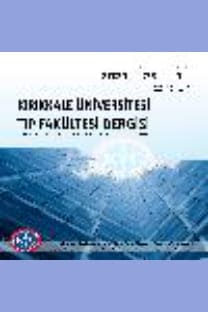RESVERATROL, PALMİTAT İLE İNDÜKLENEN ENDOPLAZMİK RETİKULUM STRESİ İNHİBE EDER: ANTİ-APOPTOTİK ETKİ
Apoptoz, endoplazmik retikulum stres, H9c2 hücre dizisi, palmitik asid, resveratrol
Resveratrol Inhibits Palmitic Acid Induced Endoplasmic Reticulum Stres: Anti-Apoptotic Effect
Apoptosis, endoplasmic reticulum stress, H9c2 cell, palmitic acid, resveratrol,
___
- Ramalingam L, Menikdewella K, LeMieux M, et al. The renin angiotensin system, oxidative stres and mitochondrial function in obesity and insulin resistance. Biochim Biophys Acta. 2016 Aug 4. [Epub ahead of print].
- Maroufi NF, Farzaneh K, Alibabrdel M, et al. Taq1B Polymorphism of Cholesteryl Ester Transfer Protein (CETP) and Its Effects on the Serum Lipid Levels in Metabolic Syndrome Patients. Biochem Genet. 2016. [Epub ahead of print].
- Ceylan-Isik AF, Kandadi MR, Xu X, et al. Apelin administration ameliorates high fat diet-induced cardiac hypertrophy and contractile dysfunction. J Mol Cell Cardiol. 2013; 63: 4-13.
- Xu X, Pang J, Chen Y, Bucala R, Zhang Y, Ren J. Macrophage migration inhibitory factor (MIF) knockout preserves cardiac homeostasis through alleviating Akt-mediated myocardial autophagy suppression in high-fat diet-induced obesity. Int J Obes. 2016; 39(3): 387-96.
- Yalcin A, Hotamisligil GS. Impact of ER protein homeostasis on metabolism. Diabetes. 2013; 62(3): 691-3.
- Gallagher EJ, Leroith D, Karnieli E. Insulin resistance in obesity as the underlying cause for the metabolic syndrome. Mt Sinai J Med. 2010; 77(5): 511-23. 7. Lee DK, Cheng R, Nguyen T, et al. Characterization of apelin, the ligand for the APJ receptor. J Neurochem. 2000; 74(1): 34-41.
- Renaud J, Bournival J, Zottig X, Martinoli MG. Resveratrol protects DAergic PC12 cells from high glucose-induced oxidative stres and apoptosis: effect on p53 and GRP75 localization. Neurotox Res. 2014; 25(1): 110-23.
- Liu MH, Lin XL, Guo DM, et al. Resveratrol protects PC12 cells from high glucose-induced neurotoxicity via PI3K/Akt/FoxO3a pathway. Cell Mol Neurobiol. 2016; 35(4): 513-22.
- Tatlidede E, Sehirli O, Velioğlu-Oğünc A, et al. Resveratrol treatment protects against doxorubicin- induced cardiotoxicity by alleviating oxidative damage. Free Radic Res. 2009. 43(3): 195-205.
- Huang CY, Ting WJ, Huang CY, Yang JY, Lin WT. Resveratrol attenuated hydrogen peroxide- induced myocardial apoptosis by autophagic flux. Food Nutr Res. 2016; 60: 30511.
- Yang B, Ma S, Wang YB, et al. Resveratrol exerts protective effects on anoxia/reoxygenation injury in cardiomyocytes via miR-34a/Sirt1 signaling pathway. Eur Rev Med Pharmacol Sci. 2016; 20(12): 2734-41.
- Gu J, Hu W, Song ZP, Chen YG, Zhang DD, Wang CQ. Resveratrol-induced autophagy promotes survival and attenuates doxorubicin-induced
- cardiotoxicity. Int Immunopharmacol. 2016; 32: 1- 7.
- Ozcan U, Yilmaz E, Ozcan L, et al. Chemical chaperones reduce ER-stres and restore glucose homeostasis in a mouse model of type 2 diabetes. Science. 2006. 313(5790): 1137-40.
- Jia G, Durante W, Sowers JR. Insulin resistance and hyperinsulinaemia in diabetic cardiomyopathy. Nat Rev Endocrinol. 2016; 12(3): 144-53.
- Cominacini L, Mozzini C, Garbin U, et al. Endoplasmic reticulum stres and Nrf2 signaling in cardiovascular diseases. Free Radic Biol Med. 2015; 88: 233-42.
- Wu LL, Russell DL, Wong SL, et al. Mitochondrial dysfunction in oocytes of obese mothers: transmission to offspring and reversal by pharmacological endoplasmic reticulum stres inhibitors. Development. 2015; 142(4): 681-91.
- Younce CW, Niu J, Ayala J, et al. Exendin-4 improves cardiac function in mice overexpressing monocyte
- chemoattractant protein-1 in cardiomyocytes. J Mol Cell Cardiol. 2015; 76: 172- 6.
- Fremont L. Biological effects of resveratrol. Life Sci. 2000: 66(8); 663-73.
- Weiskirchen S, Weiskirchen R. Resveratrol: How Much Wine Do You Have to Drink to Stay Healthy? Adv Nutr. 2016; 7(4): 706-18.
- Bonnefont-Rousselot D. Resveratrol and Cardiovascular Diseases. Nutrients. 2016; 8(5), 250; doi:10.3390/nu8050250.
- Feng J, Yang Y, Zhou Y, et al. Bakuchiol attenuates myocardial ischemia reperfusion injury by maintaining mitochondrial function: the role of silent information regulator 1. Apoptosis. 2016; 21(5): 532-45.
- ISSN: 2148-9645
- Yayın Aralığı: Yılda 3 Sayı
- Başlangıç: 1999
- Yayıncı: KIRIKKALE ÜNİVERSİTESİ KÜTÜPHANE VE DOKÜMANTASYON BAŞKANLIĞI
Elnare GÜNAL, Hayri RAMADAN, Ali BİLGİN, HANDAN ÇİFTÇİ, FİGEN ÇOŞKUN
Nadir Bir Refleks Epilepsi Türü: Sıcak Su Epilepsisi
ÖZGÜR TATLI, Selim YURTSEVER, MÜCAHİT GÜNAYDIN, Faruk ÖZŞAHİN, Gürkan ALTUNKAŞ, Nurhak AKSÜT
Süheyla KANDEMİR, GÖKÇE ŞİMŞEK, Bengi MELİKOĞLU, Mahi BALCI, NURAY BAYAR MULUK, Rahmi KILIÇ
FONKSİYONEL ENDOSKOPİK SİNÜS CERRAHİSİ HİSTOPATOLOJİ SONUÇLARIMIZ
Hatice AKAY GÜZELKÜÇÜK, GÖKÇE ŞİMŞEK, Rahmi KILIÇ
SAĞLIK ÇALIŞANLARININ TÜKENMİŞLİK, İŞ DOYUMU DÜZEYLERİ VE YAŞAM DOYUMUNUN İNCELENMESİ
ÖZLEM TEKİR, CELALETTİN ÇEVİK, Selma ARIK, Gözde CEYLAN
SEPTOPLASTİ SONRASI RETİNAL ARTER DAL OKLÜZYONU
Mesut TOZAR, Süheyla KANDEMİR, GÖKÇE ŞİMŞEK, ZAFER ONARAN, Rahmi KILIÇ
SODYUM GLUKOZ KO-TRANSPORTER 2 İNHİBİTÖRLERİNİN PLEİOTROPİK ETKİLERİ
GENÇ ERİŞKİN HASTADA SEKONDER MİDGUT VOLVULUS:OLGU SUNUMU
Erdal DEMİRTAŞ, Bülent DEMİR, Soykan TOPÇU, Esin DEMİRTAŞ, YUSUF KENAN TEKİN
RESVERATROL, PALMİTAT İLE İNDÜKLENEN ENDOPLAZMİK RETİKULUM STRESİ İNHİBE EDER: ANTİ-APOPTOTİK ETKİ
